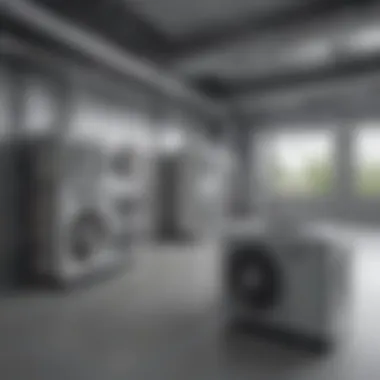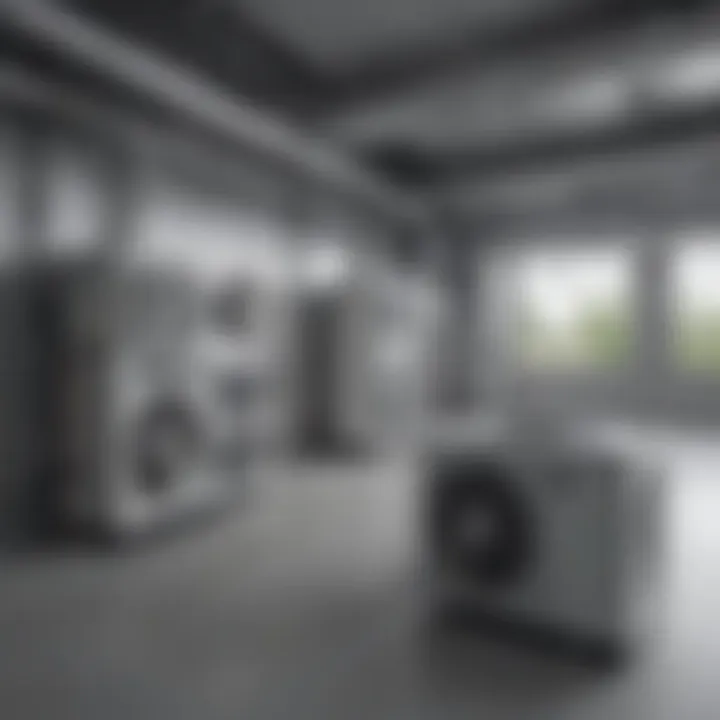Heating and Cooling Systems: Innovations and Insights


Intro
In today's world, the significance of heating and cooling systems cannot be overstated. They are essential for maintaining comfort in various environments, from homes to offices, and play a pivotal role in energy consumption. The intent of this article is to provide a thorough examination of modern climate control systems. By analyzing their mechanics, types, and efficiency, we gain valuable insights into their evolution. This exploration extends beyond mere technical understanding—it delves into the impact these systems have on the environment and energy use.
The transition towards smarter climate control solutions is also a focal point of discussion. As advancements in technology emerge, it becomes crucial to evaluate how these changes influence not only our immediate comfort but also the broader implications for sustainability. Through this analysis, we will highlight the key themes that inform the structure of our exploration, ensuring a comprehensive guide for students, researchers, educators, and professionals alike.
Research Context
Background and Rationale
Heating and cooling systems have evolved significantly over the decades, shaped by both consumer demand and technological developments. From the humble beginnings of wood-burning stoves to the sophisticated HVAC systems employed today, understanding this evolution provides context for the current state of climate control. The rationale for this article stems from a necessity to assess these systems critically, focusing on their energy efficiency and environmental impact. As global awareness of climate change grows, so does the urgency to improve our approach towards heating and cooling.
Literature Review
A review of existing literature reveals a vast body of work exploring various aspects of heating and cooling systems. Research often highlights the energy consumption of traditional systems and contrasts it with newer, more efficient technologies. Studies like those found in the archives of Britannica show the historical progression of these systems and their adaptations over time. Furthermore, scholarly articles examine the role of smart technology in enhancing efficiency. Such literature serves as a foundation for understanding where we stand today in the landscape of climate control solutions.
Methodology
Research Design
The research presented in this article follows a qualitative approach. It combines data analysis with a review of existing literature to achieve a nuanced understanding of heating and cooling systems. This design allows for an in-depth discussion of both current technologies and their historical context.
Data Collection Methods
Data for this article is collected through various sources, including academic papers, industry reports, and relevant online resources. The integration of information from platforms such as Wikipedia and community discussions on Reddit provides a well-rounded perspective on current trends and future possibilities in climate control.
"The evolution of climate control systems mirrors our changing needs and technological capabilities, paving the way for sustainable solutions."
Through this structured narrative, readers will develop a comprehensive understanding of heating and cooling systems, recognizing their critical roles in building comfort and enhancing energy efficiency.
Prologue to Heating and Cooling Systems
Heating and cooling systems are critical to our modern lives and has a significant impact on comfort, health, and productivity. This section introduces the fundamental role these systems play in maintaining indoor climate. It explains the necessity of regulating temperature for various environments, emphasizing their importance in both residential and commercial spaces.
Heating and cooling systems help optimize indoor conditions by managing temperature extremes, ensuring that spaces are maintained at comfortable levels regardless of external weather. Moreover, these systems contribute to energy efficiency when designed and used properly, significantly reducing energy consumption.
In discussing heating and cooling systems, several key elements are highlighted. These include the types of systems available, their mechanics, and their evolution over time. Recognizing the growing importance of energy efficiency and sustainability further enriches the discussion, indicating how businesses and homeowners alike can benefit from these advancements.
Defining Heating and Cooling
Heating refers to the process of increasing the temperature of a space, ensuring comfort during colder months. This is usually achieved through various methods, such as furnaces, boilers, or heat pumps. The objective is to provide a conducive indoor environment geared towards well-being.
Cooling, contrastingly, involves reducing temperature to create comfort in warmer months. Central air conditioning, individual air conditioning units, and evaporative coolers are among the common methods employed for cooling spaces. Together, heating and cooling form an essential pair in climate control, working to create a stable indoor environment.
Historical Context
The evolution of heating and cooling systems spans centuries. Early civilizations relied on rudimentary methods such as open fires, simple stoves, and natural ventilation to manage indoor climates. As time progressed, innovations emerged. The invention of the mechanical thermostat in the 18th century marked a turning point, enhancing temperature regulation.
The introduction of gas heating in the 19th century expanded heating options. The 20th century witnessed a transformation with the widespread use of central heating and air conditioning systems. This period also highlighted the relationship between technology, energy consumption, and environmental impact. As awareness of these factors increased, modern systems began to integrate energy-efficient technologies and sustainability practices.
Mechanics of Climate Control
Understanding the mechanics behind climate control is essential for grasping how heating and cooling systems operate effectively. This section examines the fundamental principles that govern these systems, specifically focusing on thermodynamics and heat transfer. Recognizing these principles can help engineers, architects, and anyone interested in climate systems appreciate their design and efficiency. The relevance of exploring these mechanics is multi-dimensional. These systems significantly impact energy consumption and user comfort. They also interact with environmental considerations, shaping how we approach modern designs.
Thermodynamics Basics
Thermodynamics is a branch of physics that deals with heat and temperature and their relation to energy and work. In climate control systems, the core of thermodynamics is applied when heat is moved, whether it's heated air, water or another medium. The laws of thermodynamics dictate how a heating or cooling system must behave when energy is added or removed.
- First Law of Thermodynamics: This law asserts that energy can neither be created nor destroyed; it can only be transformed from one form to another. In heating systems, energy is converted from fuel sources into heat. In cooling systems, the reverse occurs as heat is removed from an environment.
- Second Law of Thermodynamics: Heat will always flow from a hotter body to a cooler one. This principle is crucial for understanding how heat exchangers and refrigeration cycles function. For instance, an air conditioning unit captures heat from inside a building and expels it to the outside.
An important aspect of thermodynamics in climate control is the concept of efficiency. This efficiency can be quantified, allowing engineers to optimize systems and inform design decisions.


Heat Transfer Principles
Heat transfer is the physical process in which thermal energy moves from one system to another. There are three primary methods of heat transfer relevant to heating and cooling:
- Conduction: This is the transfer of heat through solid materials. It occurs when two surfaces at different temperatures come into contact. In heating systems, proper insulation reduces unwanted heat loss through conduction.
- Convection: This process involves the movement of fluids, such as air or water. Warm air tends to rise while cooler air sinks, creating circulation patterns that affect temperature. Understanding convection is essential for designing effective heating vents or radiator placement.
- Radiation: Unlike the other two, radiation does not require a medium to transfer heat. It occurs through electromagnetic waves. For example, the sun heats up the Earth's surface through radiation. In heating systems, radiant heating panels use this principle to warm a room from the floor up.
"Effective climate control systems must harness the principles of thermodynamics and heat transfer to optimize comfort while minimizing energy use."
By examining these mechanisms, one can appreciate how modern heating and cooling systems are not just mechanical devices but complex systems that require careful consideration in their design and implementation. Understanding these mechanics leads to better decisions, benefiting both consumers and the environment.
Types of Heating Systems
In any comprehensive analysis of climate control systems, understanding the types of heating systems is crucial. These systems have evolved significantly and can impact energy efficiency, comfort, and cost. Modern heating solutions cater to various needs and preferences, ensuring optimal thermal comfort in both residential and commercial spaces. There are multiple types of heating systems, each with its pros and cons, making it essential to evaluate them based on operational efficiency, installation requirements, and overall effectiveness.
Central Heating
Central heating systems distribute heat from a single location throughout a building or home. These systems usually use a network of ducts or pipes to convey hot air or water to various rooms. The primary benefits of central heating include:
- Even Temperature Distribution: Central heat allows for uniform warmth in different spaces, reducing cold spots.
- Energy Efficiency: When designed properly, these systems can be more energy-efficient compared to individual heating units.
- Automation: Many central heating systems can be integrated with smart thermostats, allowing for easier temperature control.
However, installing a central heating system can be more invasive and costly compared to other heating options. Proper maintenance is essential to ensure longevity and efficiency.
Space Heaters
Space heaters serve as localized heating solutions. These devices provide focused warmth in specific areas, making them ideal for supplemental heating. Some key features of space heaters are:
- Affordability: Generally, they are cheaper to install and operate than central heating systems.
- Portability: Many space heaters are lightweight and can be easily moved from room to room.
- Instant Heat: Unlike central systems, space heaters provide immediate warmth, which can be beneficial in quickly cooling spaces.
On the downside, reliance on space heaters can lead to increased energy consumption if used excessively. Furthermore, safety should be a concern as some models can pose fire risks if not monitored carefully.
Radiant Heating
Radiant heating systems operate by directly heating objects in a room rather than warming the air. This method can include heated floors or panels in walls and ceilings. The advantages of radiant heating are:
- High Comfort Level: Radiant heat provides consistent warmth without drafts, offering a more comfortable environment.
- Energy Efficiency: These systems typically use less energy than forced air systems, lowering operational costs.
- Quiet Operation: Radiant heating systems operate quietly, eliminating the noise often associated with traditional heating systems.
However, radiant heating systems can have higher installation costs and may require a longer period to warm up a space initially.
Types of Cooling Systems
Understanding the types of cooling systems is crucial for anyone working with climate control solutions. Each system has its unique characteristics, advantages, and drawbacks. With the right knowledge, individuals and organizations can make informed decisions about their cooling needs. This section delves into three primary types of cooling systems: Air Conditioning Units, Evaporative Coolers, and Chiller Systems.
Air Conditioning Units
Air conditioning units are prevalent in both residential and commercial settings. They cool air through a vapor-compression cycle, utilizing refrigerants. Key benefits include precise temperature control, humidity reduction, and ease of use. Modern air conditioners often come equipped with programmable thermostats, enhancing their efficiency.
However, they have potential downsides. Energy consumption can be high, especially if units are not maintained properly. Regular maintenance and cleaning are essential to ensure efficiency and extend the lifespan of the system.
"Efficient air conditioning can significantly reduce indoor humidity and improve comfort levels in hot, humid climates."
Evaporative Coolers
Evaporative coolers, also known as swamp coolers, function differently than traditional air conditioning units. They use the principle of evaporative cooling to lower temperatures. Water is evaporated into the air, resulting in cooler outdoor air being drawn inside. This type of cooling is particularly effective in arid climates.
Some advantages of evaporative coolers include low energy consumption and the use of water instead of refrigerants. They have lower installation costs compared to air conditioning units. However, their effectiveness wanes in humid environments where moisture levels are already high, curbing their cooling ability.
Chiller Systems
Chiller systems, often utilized in larger buildings and industrial applications, operate using a refrigeration cycle. They are designed to remove heat from a liquid through a vapor-compression or absorption cycle.
These systems are essential for maintaining comfortable temperatures in large spaces. Chillers can also provide cooling for industrial processes, making them versatile and crucial in various applications. On the downside, refrigerated chillers can be complex and require significant maintenance. Choosing the right type of chiller according to the building’s specific cooling needs is important for efficiency and effectiveness.


In summary, each type of cooling system has distinct features and considerations. Evaluating the specific needs and conditions of a space will lead to better decisions regarding cooling solutions.
Energy Efficiency Considerations
Energy efficiency in heating and cooling systems is crucial for both environmental sustainability and economic savings. As climate control plays a pivotal role in building comfort, understanding energy efficiency poses numerous benefits. Higher efficiency systems consume less energy, which can lead to substantial reductions in utility bills.
Furthermore, energy-efficient systems have a lower carbon footprint. With increasing concerns regarding global warming and ecological impact, reducing energy consumption becomes a collective responsibility. The integration of energy-efficient systems contributes positively to long-term environmental goals, helping to alleviate some of the pressures of climate change.
Understanding SEER Ratings
Seasonal Energy Efficiency Ratio (SEER) ratings are pivotal for assessing the efficiency of cooling systems, especially air conditioners. This rating measures the total cooling output during a typical cooling season divided by the total electric energy input during the same period. A higher SEER rating indicates a more efficient system.
For example, a unit with a SEER rating of 16 is clearly more efficient than a unit rated at 10. Although higher SEER systems may have a higher initial cost, the long-term savings on energy bills can offset this initial investment. Additionally, many regions offer incentives or rebates for purchasing higher efficient models, further enhancing their appeal.
The Role of Insulation
Insulation plays a vital role in energy efficiency for heating and cooling systems. Good insulation minimizes heat transfer between the indoors and outdoors. This means a well-insulated space keeps the desired temperature for longer periods, resulting in decreased energy demand.
Common materials used for insulation include fiberglass, foam boards, and spray foam. Proper insulation not only improves heating and cooling efficiency, but it also enhances overall comfort. If you can maintain a steady indoor temperature with less energy, you can achieve significant savings.
The Impact of Thermostats
Thermostats are important components of climate control systems. They help maintain the desired temperature, but modern smart thermostats take this a step further. Smart thermostats can learn habits and adjust the settings based on when and how a space is used. This can lead to even greater energy savings.
For instance, when no one is home, a smart thermostat can adjust the temperature to a more energy-efficient setting. In this way, it prevents unnecessary heating or cooling, contributing to lower energy consumption. Moreover, many smart thermostats can be controlled remotely, providing convenience and increasing user engagement in energy-saving practices.
"Energy efficiency not only leads to cost savings but also to environmental benefits, making it a key consideration in modern heating and cooling systems."
Environmental Impact
Heating and cooling systems are integral to modern life, yet their influence on the environment is significant. The need to manage these systems goes beyond personal comfort; it also concerns sustainability and climate change.
Consideration of environmental impact in this context involves several dimensions, including energy consumption, emissions, and resource use. Understanding these factors can lead to more informed choices about which systems to implement and how to optimize their use.
Carbon Footprint of HVAC Systems
The carbon footprint of heating, ventilation, and air conditioning (HVAC) systems is substantial. These systems contribute to greenhouse gas emissions primarily through energy consumption. According to recent estimates, HVAC systems account for almost 15% of global carbon emissions. This figure underscores the importance of improving energy efficiency in these systems to mitigate environmental damage.
Key factors that influence the carbon footprint include:
- Energy Source: The type of energy feeding the HVAC system significantly affects its overall emissions. Renewable energy sources such as solar or wind reduce carbon footprint compared to fossil fuels.
- System Efficiency: Units with higher SEER (Seasonal Energy Efficiency Ratio) ratings tend to have lower emissions, as they utilize less energy for the same level of output.
- Maintenance Practices: Regular maintenance can enhance efficiency, reducing energy use and, subsequently, emissions.
By investing in energy-efficient systems and transitioning to renewable energy sources, it’s possible to reduce the carbon footprint of HVAC systems.
Regulations and Standards
Regulations and standards play a crucial role in shaping the environmental impact of heating and cooling technologies. These guidelines ensure that products meet minimum efficiency levels and reduce harmful emissions.
To address climate concerns, multiple regulations have been implemented at national and international levels:
- Energy Efficiency Standards: Governments often set mandatory efficiency ratings for HVAC equipment. The Energy Star program is one example in the United States, which helps consumers identify energy-efficient products.
- Refrigerant Regulations: Many countries have phased out high global warming potential refrigerants in favor of more environmentally friendly options. This shift is crucial since refrigerants can trap heat in the atmosphere significantly more than carbon dioxide.
- Building Codes: Local building codes often dictate the minimum standards for insulation and thermal performance in buildings. These codes have a direct influence on the effectiveness of heating and cooling systems.
Adhering to these regulations not only benefits the environment but also strengthens the energy economy, helping address climate change challenges.
Smart Heating and Cooling Technologies
Smart heating and cooling technologies represent a significant shift in how we manage indoor climate. With rising concerns about energy efficiency and environmental sustainability, these technologies provide innovative solutions that optimize energy use while enhancing comfort. They integrate advanced features that enable consumers to make informed decisions about their energy consumption. As we delve into this topic, we will explore key components like smart thermostats and remote monitoring systems, each playing a vital role in revolutionizing climate control.
Smart Thermostats
Smart thermostats are central to modern heating and cooling systems. Unlike traditional units that simply maintain set temperatures, smart thermostats learn user preferences and adjust accordingly. These devices consider various factors, including time of day, occupancy, and even weather forecasts. This dynamic adjustment leads to more efficient energy consumption.


Second, most smart thermostats provide apps that allow for remote control. Users can adjust settings from anywhere using a smartphone. This feature promotes energy savings, especially when people forget to change the temperature before leaving home.
In addition to convenience, these devices support energy conservation efforts. Many offer reports on energy usage, helping users identify unnecessary consumption. Homeowners can adapt their behaviors based on these insights, which contributes to an overall reduction in energy bills.
Although the initial cost of smart thermostats can be higher than traditional models, the long-term savings often outweigh these costs. Government incentives may also be available, making the investment more appealing.
Remote Monitoring Systems
Remote monitoring systems take smart technology a step further. These systems continuously track the performance of heating and cooling units and provide real-time feedback. They offer valuable insights into operations and efficiency, which can prevent costly breakdowns.
One of the key advantages of remote monitoring is its diagnostic capabilities. By analyzing data, these systems can predict potential issues before they escalate into significant problems. Homeowners can address maintenance needs proactively, extending the life of their systems.
Furthermore, these systems often integrate with smart home platforms, enabling seamless control and automation. For example, users can set schedules for their heating and cooling systems that align with their daily routines. This coordination not only enhances comfort but also minimizes energy wastage.
The convergence of smart heating and cooling technologies is not just about comfort; it’s about creating sustainable living environments that conserve resources and reduce environmental impact.
In summary, smart heating and cooling technologies, including smart thermostats and remote monitoring systems, play a crucial role in modern climate control. They empower users, optimize energy usage, and promote sustainability in a world increasingly concerned about ecological footprints. Embracing these technologies today will shape more efficient homes for the future.
Future Trends in Heating and Cooling
The landscape of heating and cooling systems is undergoing a transformation, driven by innovation and a growing emphasis on sustainability. Understanding the future trends in this industry is crucial for students, researchers, educators, and professionals who are invested in climate control solutions. With evolving technologies and new sustainability initiatives, it is essential to grasp the elements that will shape these systems. This section introduces significant trends that will influence future developments in heating and cooling.
Emerging Technologies
Emerging technologies are the backbone of modern climate control systems. One noteworthy advancement is the integration of machine learning and artificial intelligence within smart heating and cooling systems. These technologies enhance energy management by optimizing usage patterns based on user behavior and preferences. For example, a smart thermostat can learn household routines, adjusting the temperature automatically to save energy when needed. This not only minimizes energy waste but also promotes cost savings for users.
Another important trend is the shift towards heat pump technologies. Heat pumps can both heat and cool spaces efficiently by extracting heat from the environment. They work by transferring thermal energy, rather than generating heat through combustion, thereby reducing greenhouse gas emissions. The enhanced efficiency of heat pumps makes them an attractive option for residential and commercial applications.
Moreover, advancements in renewable energy sources, such as solar thermal systems, are gaining traction. These systems harness solar energy to provide heating, significantly lowering reliance on fossil fuels. In regions with high solar exposure, such systems can be particularly effective, providing sustainable energy solutions.
"The future of heating and cooling rests on the ability to innovate and adapt to changing environmental and technological landscapes."
Sustainability Initiatives
Sustainability initiatives are becoming increasingly relevant in the context of heating and cooling. Regulations are evolving, with governments pushing for stricter efficiency standards and promoting the adoption of low-carbon technologies. As a response, manufacturers are developing products that meet or exceed these regulations, demonstrating a commitment to reducing environmental footprints.
In addition, the development of sustainable materials for HVAC systems is a key area of focus. Companies are exploring alternatives to traditional materials, opting for recyclable and low-impact options. This shift not only supports sustainability goals but can also improve system performance in terms of efficiency and lifecycle costs.
Furthermore, the incorporation of sustainable practices in the installation and maintenance of heating and cooling systems is vital. Professionals in the field are increasingly expected to prioritize energy efficiency, ensuring that systems operate at optimal levels throughout their lifespan. This includes regular maintenance to prevent inefficiencies and the use of eco-friendly refrigerants that comply with environmental standards.
The importance of educating consumers about the benefits of sustainable heating and cooling cannot be overstated. Increased awareness leads to informed choices, resulting in wider adoption of eco-friendly systems. By blending technology and sustainability, modern climate control solutions will play a significant role in steering us towards a more sustainable future.
Epilogue and Implications for the Future
The topic of heating and cooling systems is essential in understanding our current and future climate control strategies. The implications are far-reaching as these systems not only affect individual comfort but also have significant impacts on energy consumption and environmental sustainability.
This article has discussed various types of heating and cooling systems, including their efficiencies and environmental influences. By summarizing these critical points, we can better appreciate the complexity and importance of these systems in modern life.
- Energy Efficiency: Greater emphasis on energy-efficient systems reduces overall consumption, saving costs over time.
- Environmental Responsibility: Understanding the impact of HVAC systems on the environment prompts the development of greener technologies.
- Technological Innovations: Smart technology integration into heating and cooling represents a shift towards more responsive systems that can adapt to user needs and reduce energy usage.
The future will likely bring even more advanced solutions that prioritize sustainability. Those involved in the design, installation, and regulation of these systems must adapt to changes in technology and public expectation.
"The ongoing transition towards smarter systems invites not just improvement in energy consumption but also presents opportunities for innovation and environmental stewardship."
Summarizing Key Points
To encapsulate the main findings of this article, consider the following:
- Variety of Systems: Different systems from central heating to smart thermostats cater to diverse needs and environments.
- Energy Ratings: Understanding systems' SEER ratings, insulation roles, and the function of smart technology is vital for making informed choices.
- Sustainability: The emphasis on reducing the carbon footprint and adopting environmentally friendly technologies is becoming more pronounced in industry standards and consumer choices.
By acknowledging these points, both consumers and professionals can make choices that align with their values regarding comfort, efficiency, and sustainability.
Role in Modern Society
In modern society, heating and cooling systems occupy a pivotal role in enhancing quality of life. They contribute to health and productivity in residential and commercial spaces alike.
- Comfort and Health: Maintaining comfortable indoor temperatures has direct implications for physical and mental well-being. Temperature regulation helps mitigate health risks associated with extreme weather conditions.
- Economic Factors: Effective climate control systems can reduce energy bills and increase property values through improved efficiencies and sustainable features.
- Technological Adoption: The rise of smart technology fosters user engagement and enables better management of energy resources, providing a glimpse into a more automated future.
The integration of these systems into our daily lives underscores their importance in fostering adaptability and resilience in the face of environmental challenges. They serve as a critical infrastructure that supports both individual livelihoods and broader societal functions.



